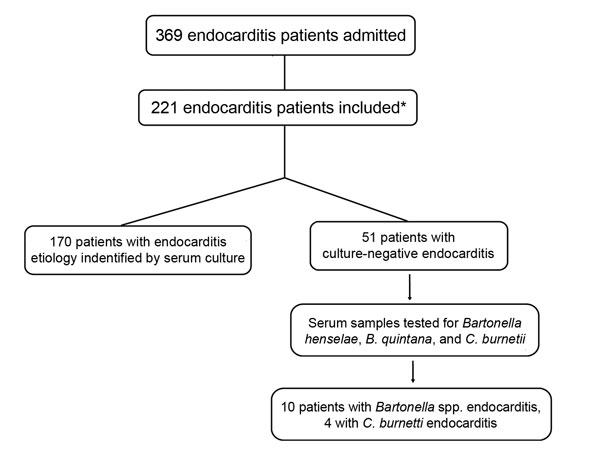Volume 21, Number 8—August 2015
Dispatch
Bartonella spp. and Coxiella burnetii Associated with Community-Acquired, Culture-Negative Endocarditis, Brazil
Figure

Figure. Distribution of patients etiologically diagnosed with endocarditis and admitted to the heart institute (Instituto do Coração) at the University of São Paulo Medical School, Sao Paulo, Brazil, January 2004–January 2009. *A modified Duke criteria (3) was used to determine inclusion of 221 patients. Excluded were 148 patients: 58 with unconfirmed endocarditis, 28 with endocarditis caused by cardiac implantable electronic devices, 47 with nosocomial endocarditis, and 15 hemodialysis patients.
References
- Tattevin P, Watt G, Revest M, Arvieux C, Fournier PE. Update on blood culture-negative endocarditis. Med Mal Infect. 2015;45:1–8. DOIPubMedGoogle Scholar
- Fournier PE, Thuny F, Richet H, Lepidi H, Casalta JP, Arzouni JP, Comprehensive diagnostic strategy for blood culture-negative endocarditis: a prospective study of 819 new cases. Clin Infect Dis. 2010;51:131–40. DOIPubMedGoogle Scholar
- Li JS, Sexton DJ, Mick N, Nettles R, Fowler VG Jr, Ryan T, Proposed modifications to the Duke criteria for the diagnosis of infective endocarditis. Clin Infect Dis. 2000;30:633–8. DOIPubMedGoogle Scholar
- Ben-Ami R, Giladi M, Carmeli Y, Orni-Wasserlauf R, Siegman-Igra Y. Hospital-acquired infective endocarditis: should the definition be broadened? Clin Infect Dis. 2004;38:843–50. DOIPubMedGoogle Scholar
- Fournier PE, Mainardi JL, Raoult D. Value of microimmunofluorescence for diagnosis and follow-up of Bartonella endocarditis. Clin Diagn Lab Immunol. 2002;9:795–801 .PubMedGoogle Scholar
- Raoult D. Chronic Q fever: expert opinion versus literature analysis and consensus. J Infect. 2012;65:102–8. DOIPubMedGoogle Scholar
- Schneeberger PM, Hermans MH, van Hannen EJ, Schellekens JJ, Leenders AC, Wever PC. Real-time PCR with serum samples is indispensable for early diagnosis of acute Q fever. Clin Vaccine Immunol. 2010;17:286–90. DOIPubMedGoogle Scholar
- Raoult D, Houpikian P, Tissot Dupont H, Riss JM, Arditi-Djiane J, Brouqui P. Treatment of Q fever endocarditis: comparison of 2 regimens containing doxycycline and ofloxacin or hydroxychloroquine. Arch Intern Med. 1999;159:167–73. DOIPubMedGoogle Scholar
- Rolain JM, Mallet MN, Raoult D. Correlation between serum doxycycline concentrations and serologic evolution in patients with Coxiella burnetii endocarditis. J Infect Dis. 2003;188:1322–5. DOIPubMedGoogle Scholar
- Siciliano RF, Strabelli TM, Zeigler R, Rodrigues C, Castelli JB, Grinberg M, Infective endocarditis due to Bartonella spp. and Coxiella burnetii: experience at a cardiology hospital in Sao Paulo, Brazil. Ann N Y Acad Sci. 2006;1078:215–22. DOIPubMedGoogle Scholar
- Siciliano RF, Ribeiro HB, Furtado RH, Castelli JB, Sampaio RO, Santos FC, Endocarditis due to Coxiella burnetii (Q fever): a rare or underdiagnosed disease? Case report [in Portuguese]. Rev Soc Bras Med Trop. 2008;41:409–12. DOIPubMedGoogle Scholar
- Lamas CC, Ramos RG, Lopes GQ, Santos MS, Golebiovski WF, Weksler C, Bartonella and Coxiella infective endocarditis in Brazil: molecular evidence from excised valves from a cardiac surgery referral center in Rio de Janeiro, Brazil, 1998 to 2009. Int J Infect Dis. 2013;17:e65–6. DOIPubMedGoogle Scholar
- Corrêa FG, Pontes CLS, Verzola RMM, Mateos JCP, Velho PENF, Schijman AG, Association of Bartonella spp bacteremia with Chagas cardiomyopathy, endocarditis and arrythmias in patients from South America. Braz J Med Biol Res. 2012;45:644–51. DOIPubMedGoogle Scholar
- Raoult D, Casalta JP, Richet H, Khan M, Bernit E, Rovery C, Contribution of systematic serological testing in diagnosis of infective endocarditis. J Clin Microbiol. 2005;43:5238–42. DOIPubMedGoogle Scholar
Page created: July 15, 2015
Page updated: July 15, 2015
Page reviewed: July 15, 2015
The conclusions, findings, and opinions expressed by authors contributing to this journal do not necessarily reflect the official position of the U.S. Department of Health and Human Services, the Public Health Service, the Centers for Disease Control and Prevention, or the authors' affiliated institutions. Use of trade names is for identification only and does not imply endorsement by any of the groups named above.